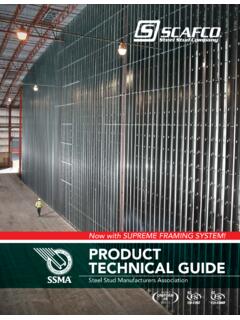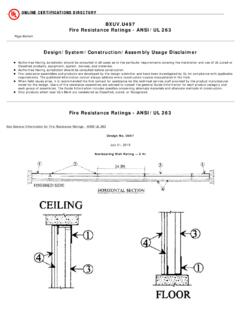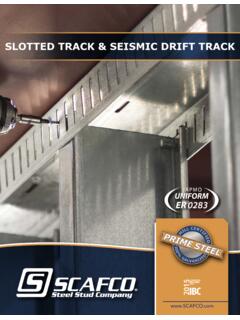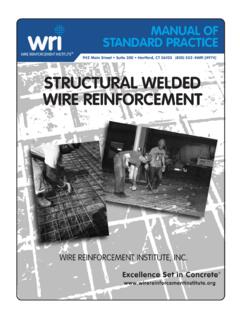Transcription of Introduction Coating Weight [Mass] Measurement Systems
1 GalvInfo Center email: Toll-free phone: 1-888-880-8802 1 Coating Weight Measurement There is a very precise on-line technique for measuring Coating thickness. The equipment required is expensive, uses sophisticated x-ray or radio-isotope fluorescence devices, and requires considerable expertise to operate. These gauges repeatedly sense the Coating thickness on each surface, average a large number of readings, and then convert the results to the more familiar Coating Weight units.
2 Laboratory versions of this equipment are also available. Refer to ASTM Test Method A754 for more information. These gauges require calibration based on weigh-strip-weigh testing. 1. Metallic-Coated Products and Specifications GalvInfoNote understanding Coating Weight designations for Zinc-Based Coatings on Steel Sheet Rev Introduction One of the most confusing aspects of coated steel sheet products are Coating Weight designations and what they mean, particularly with respect to product performance. This article is intended to clarify this issue.
3 Coating Weight [Mass] Measurement Systems Each coated steel sheet product has its own Coating Weight designation system, which is defined in the appropriate ASTM standard. For example, the most widely used ASTM metallic-coated sheet standard is A 653/A 653M, which covers hot-dip galvanized products. One of the Coating Weight designation Systems in this standard uses descriptors such as G60, G90, etc. The G means the Coating is galvanize (zinc), and the numbers refer to the Weight of zinc on the surface of the steel sheet in inch-pound (English/Imperial) units. Taking G90 as an example, the Coating Weight on one square foot of sheet (total, both sides of the sheet) shall have a triple spot test (TST) average minimum of ounces.
4 If equally applied to both sides of the sheet, there would be a minimum of ounces on each surface. The other Measurement system in widespread use today is the SI (Metric) system. The conversion from the inch-pound Weight in ounces per square foot (oz/ft2) to the SI mass in grams per square metre (g/m2) is: 1 oz/ft2 = g/m2 To convert from oz/ft2 to g/m2, multiply by Example: G90 ( oz/ft2) = Z275 (275 g/m2) If what we are interested in is the Coating thickness, why do ASTM standards not use thickness measurements? The answer is simply that it is difficult to directly measure the thickness accurately.
5 For example, a G90 Coating contributes about mils ( inches, or about 42 microns) to the total thickness of the coated sheet. For a Coating equally applied to both sides of the sheet, this means there is about inches (21 microns) of zinc on each surface. To accurately determine the thickness of the Coating , the coated thickness must be measured, the Coating stripped off, and then the steel substrate thickness measured using a gauge capable of accurately reading to the nearest ten-thousandth of an inch. This is very difficult to do with good accuracy.
6 On-line equipment is available that can nondestructively do this (see sidebar), but the most accurate manual method of determining the amount of Coating present is to measure its Weight [mass] on a given surface area using the weigh-strip-weigh technique. Weigh-strip-weigh refers to the procedure of weighing a standard size sample of the product using a very accurate scale, stripping the Coating in an inhibited acid without removing any of the substrate, then reweighing the coupon to determine the Weight [mass] loss. This is the original method of determining Coating Weight [mass], and, in fact, is still the referee and standard method used to check and calibrate nondestructive on-line and laboratory Coating thickness gauges.
7 There are weigh-strip-weigh procedures that can be used for all zinc-based coatings in commercial production today. For the most common products, these procedures are defined in ASTM Standard A 90/A 90M, and cover galvanized and galvannealed sheet, 55% aluminum-zinc alloy-coated sheet, and zinc-5% aluminum alloy-GalvInfoNote Rev Mar-09 GalvInfo Center email: Toll-free phone: 1-888-880-8802 2 coated sheet. There are special procedures required for other types of alloy coatings such as aluminized, and zinc-nickel alloy electroplated sheet.
8 These are covered by other ASTM standards. Designation System for Galvanized and Galvannealed Sheet Products Galvanize For galvanized sheet, common inch-pound Coating Weight designations (ordered as A 653) are, in oz/ft2: G30 G40 G60 G90 G115 These designations specify the minimum average TST, total both sides, tested per ASTM A 924/A 924M, , G90 requires a minimum average TST of oz/ft2 total both sides. The specification stipulates that TST samples shall be taken from defined positions at the edge-center-edge of the as-coated sheet.
9 There are designations for heavier coatings, such as G165 and G210, but these products are used for very specialized applications and are generally not available on thinner gauge sheet. In SI units (ordered as A 653M), the comparable Coating mass designations for galvanized sheet are, in g/m2: Z90 Z120 Z180 Z275 Z350 These designations specify the minimum average TST, total both sides, tested per A 924/A 924M, , Z275 requires a minimum average TST of 275 g/m2 total both sides. In 2007 ASTM added the option of ordering single side, single spot test (SST) Coating designations to A 653/A 653M.
10 These are SI designations only (ordered to A 653M) and specify the minimum and maximum allowable Coating mass per side for any SST. They take the familiar form of automotive Coating designations (numeric characters first signifying a per side requirement). No inch-pound designations are used since single side coatings are traditionally ordered in SI units only. Examples are: 60G 70G 90G These designations specify the minimum and maximum SST value on each surface, , 60G requires a minimum of 60 g/m2 and a maximum of 110 g/m2 of zinc on each surface for any SST.






